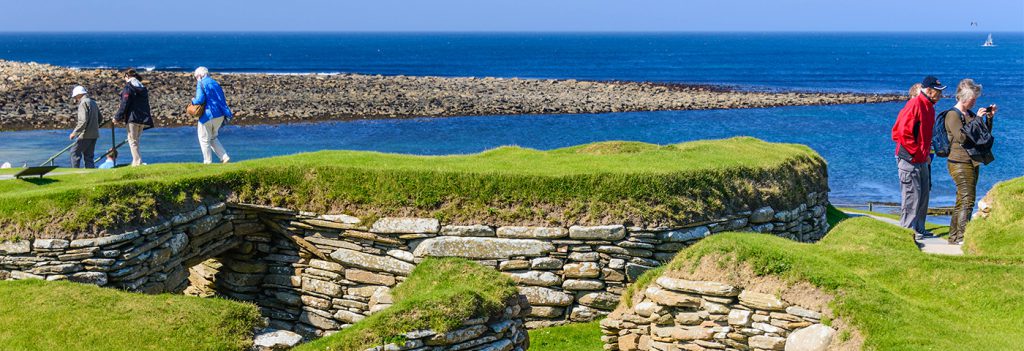How does a small archipelago cope with becoming Britain’s most successful cruise destination? In 2011 there were 36,000 cruise passengers, last year there were close to 100,000, projected to hit 141 ships and 126,000 arrivals this year – a three and a half-fold increase in numbers. In 2018 the first 5,000 berth ships are due to arrive. Inevitably, just as in Venice, the cruise liners overshadow the islands and swamp the honeypot sites.
Rousay, one of the Orkney islands, is often described as the Egypt of the North – don’t dismiss this as guidebook hyperbole, Orkney is an archaeological treasure trove and Skara Brae precedes the Pyramids of Giza in Egypt. With 90,000 visitors in 2016, it expects to reach 100,000 this year.
Orkney is an archipelago of 70 islands, 20 of which are inhabited, 16 kilometres off the north coast of Scotland. The islands have been inhabited for at least 8500 years; there is evidence of nomadic Mesolithic occupation and the Knap of Howar, a Neolithic farmstead on Papa Westray, was a permanent settlement as early as 3,500BCE. On mainland Orkney the village of Skara Brae, Europe’s best preserved Neolithic settlement, was inhabited from 3,100BCE to 2,500BCE when it was abandoned – perhaps because of climate change.
There is rich archaeology on Orkney from the Neolithic through the Iron Age, the Picts and Vikings to the remains of World I and II fortifications and a charming Italian Chapel built and decorated by Italian prisoners of war, working on the Churchill Barriers which now connect several islands to the Orkney mainland. Separated from Scotland and the UK by the Pentland Firth, well known for the strength of its tides among the fastest in the world, Orkney has maintained a distinctive Orcadian culture, proud of its inheritance. The population declined from a peak of 26,500 in 1851 to around 17,000 in 1971, since when the population has grown with inward migration to around 22,000.
Through Caroline Warburton of the Scottish Tourism Alliance, I was invited to speak at the Orkney Tourism Group’s Tourism Summit during Scottish Tourism Week last week. I posed the question: Will Orkney be used by tourism or will it use tourism for its sustainable development?
Orkney is a distinctive place with a strong local culture and an unusual concentration of quality crafts, music and storytelling. The industry is largely locally owned, there are hotels but they are relatively small, their growth constrained by strong seasonality, inward investment in tourism has been by incomers who have arrived to make Orkney their own and to adopt the Orcadian culture.
The “discovery” of Orkney by the cruise lines has led to some strains within the tourism community and concerns about overtourism. The islands have a relatively high level of repeat visitors and when the cruise ships are in the honeypot sites are crowded. It is hardly a surprise that the local accommodation providers are concerned about the impact of day visitors crowding out the staying tourists on congested sites – it is an inevitable topic of conversation over breakfast.
At the Tourism Summit leaders in the local industry were arguing that cruise tourism is a part of the industry, not something separate from it. The local authority has control of the harbour, planning, infrastructure development and tourism, if the private sector can come to a workable consensus and work with the public sector, the Orcadians will be able to use tourism for their sustainable development and enable more young people to find attractive employment and to stay.
The Ring of Brodgar (below) is on private land to which the farmer willingly grants free access. The local authority has provided a coach park and the free site inevitably attracts large numbers of visitors. In early spring the trampling damage is very evident – the site needs hardening and an appropriate visor management to maintain its quality.
Skara Brae (below) is well managed and even with 90,000 visitors last year there is no sign of trampling damage. Site management can raise the carrying capacity of the honeypot sites and information can be provided locally about when the pressure from cruise passengers is greatest – this will encourage staying tourists to visit the other islands and help spread the benefits of tourism across the islands.
The Orkney Tourism Group is discussing with local government how they might form a community interest company to manage tourism on the islands, exercising more control over the cruise lines and their passengers to maximise the positive impacts and significantly reduce the negative impacts. Revenues from the cruise sector could be used to extend the season, making staying tourism more viable. Berthing permits and charges could be used to ensure that the local guides and small driver guide operators are able to access the cruise passenger market and profit from it. The cruise liners are seasonal floating hotels accommodating visitors who spend on local crafts and create employment for operators and guides. When the season ends the liners leave, they do not add to the problems of seasonal employment and they do not permanently scar the landscape with buildings which may not be sufficiently profitable to be adequately maintained.
Orkney will feature in the Responsible Tourism programme at WTM London in November – it will be interesting to see how much progress has been made by then.
